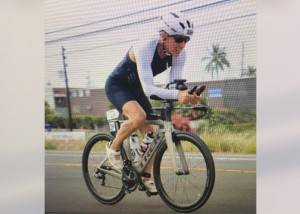

By Garth Shanklin
Sports Editor
Triathalons are not easy.
Running, biking and swimming require different skill sets that take time to master, and doing all of them while racing against other people is a difficult task.
Now, pretend the people you’re racing against are the best athletes in the world and the race itself is on an island near a volcano.
That’s the kind of competition and course you’ll find at the Kona Ironman event, which Union Township’s Michael Miller competed in earlier this year.
Miller started his path to Kona at smaller events decades ago and kept working at it until he finally qualified last year.
“I started with marathons 20 years ago, and worked from there to endurance competitions to triathalons ,” Miller said. “I worked my way up to the Ironman distance. I started with Olympic distance, then to HFP and to Ironman.”
Miller said he had competed in triathalons for the past 18 years, but even still, numerous hours of training were required in order to get ready for Kona.
“I had 20 hour weeks of training,” Miller said. “That would have different portions. I’d swim three or four times a week, anywhere from 6,000 meters per week swimming. Biking I would do about three session per week with a longer ride on the weekends, up to five hours. Same with the runs, I would do speed work during the week and then the longer two, 2.5 hour run during the weekends.”
That training helped Miller join a small list of men who qualified for the championships. There are not too many Ironman races in the world, and there are fewer spots for his age group.
“There’s 40 or so Ironman races throughout the world,” Miller said. “In the United States, there are different ones throughout. There are 40 slots at each Ironman race for all the age groups, and depending on how big the age group is they get so many slots. My group was 55-59 at Chattanooga, Tennessee last September and there were two slots. There were about 200 people in the age group.”
Looking back on his experience at Kona, Miller said being able to compete with the top athletes in the world is one of the things he’ll remember most about his time there.
“That was a real privilege to race with all the athletes throughout the world that qualified for the Kona Ironman,” Miller said. “It was a great experience to be with that depth of competition. You’re with the worlds best, and you’re side-by-side with the pros that are competing. That’s quite an experience.”
It was not an easy trip, however. Miller said there are a few things he had to overcome, mostly relating to the conditions the race was held in.
“For me, personally, the swim in the open sea,” Miller said. “It’s out in the Pacific and the swells are pretty big. Sighting the buoys was pretty tough for me. The second half of the marathon portion, with the heat. It’s the third leg of the triathalon, and it’s very tough. Kona is very hot, it’s arid and dry. You’re in the lava fields, and that radiates the heat quite a bit. It’s the world championships, it’s the toughest course.”
Now that he’s back in the Buckeye State, Miller said he’s not done with triathalons yet and is always looking for more events to attend. He added he’d also be interested in qualifying for the Kona Ironman Championships one more time.
“There are some local events I enjoy in Ohio,” Miller said. “The HFP Triathalon racing series and I’d like to compete in another Ironman. I’d try to get qualified for Kona again, I’d like to do that.”
When asked for advice for anyone interested in starting their own journey to Kona, Miller was quick to note the equipment you use is not nearly as important as the ability of the person using it. Training is key.
“Start out by looking for local races,” Miller said. “You don’t need the best equipment or anything. Start with a sprint or an Olympic distance race. Go to your local YMCA and get some swim training there. The biggest thing is getting over the fear of open water swimming. Once they conquer that, they’re pretty much on their way.”
